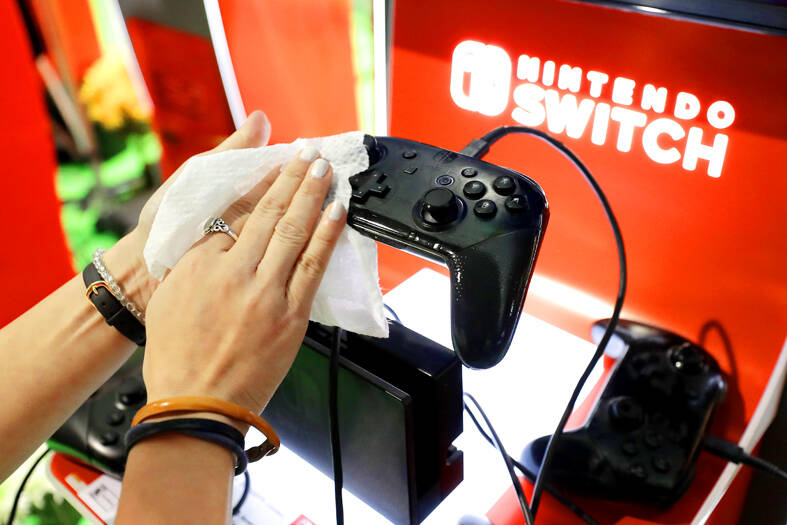Nintendo Co plans to increase production of its six-year-old Switch in the next fiscal year after shipping about 21 million of the consoles in the year ending in March, people familiar with the matter said.
The Kyoto-based company had lowered its sales forecast for the console to 19 million units in November last year because of component shortages, but is convinced it can make more and demand remains strong, the people said, asking not to be named because the discussions are not public.
The move to increase output is an unexpected measure at a late stage in the console’s life cycle.

Photo: AP
Nintendo has told suppliers and assembly partners that it intends to churn out more Switch units in the fiscal year starting in April, but has not yet communicated a precise target, the people said.
It might revise down its plans later in the year if demand underwhelms, they said.
However, analyst expectations are for sales to diminish. Nintendo’s plan suggests it sees sustained demand for at least another year.
With prices starting at US$199.99, the console has been hampered more by supply issues than any demand slump, Nintendo executives said.
“Sales in the recent holiday season were not that strong even with improved supply,” UBS Securities Ltd analyst Kenji Fukuyama said.
“People will soon start speculating about next-generation hardware and are likely to refrain from buying the old system. A slowdown in Switch sales momentum is unavoidable,” Fukuyama said.
Switch console sales have historically been driven by the launch of marquee games, such as Animal Crossing: New Horizons during the COVID-19 pandemic, and Nintendo has several titles from blockbuster franchises such as The Legend of Zelda series that is to debut this year.
Meeting Nintendo’s 19 million unit sales target for this fiscal year and going above that in the next one would bring the Switch into the rarefied territory of about 150 million lifetime sales — a mark surpassed only by Sony Group Corp’s PlayStation 2.
Semiconductor and component shortages have diminished across the electronics industry in recent months, with Sony executives expressing confidence that its PlayStation 5 console would be much more widely available this year than previously.
Nintendo can grow its Switch sales in the coming year, especially if it gives them a boost with game-themed special editions of the console, Tokyo Securities Co analyst Hideki Yasuda said.
The company last year released a Splatoon 3 edition of its most expensive Switch OLED model, decorating the hardware with illustrations from the popular third-person shooter and helping drive sales.
The company plans to release The Legend of Zelda: Tears of the Kingdom — the highly anticipated sequel to Breath of the Wild, a game that was synonymous with the Switch in its early days — in May.
A Zelda-themed Switch would entice existing console owners to buy another unit, Yasuda said.

The US dollar was trading at NT$29.7 at 10am today on the Taipei Foreign Exchange, as the New Taiwan dollar gained NT$1.364 from the previous close last week. The NT dollar continued to rise today, after surging 3.07 percent on Friday. After opening at NT$30.91, the NT dollar gained more than NT$1 in just 15 minutes, briefly passing the NT$30 mark. Before the US Department of the Treasury's semi-annual currency report came out, expectations that the NT dollar would keep rising were already building. The NT dollar on Friday closed at NT$31.064, up by NT$0.953 — a 3.07 percent single-day gain. Today,

‘SHORT TERM’: The local currency would likely remain strong in the near term, driven by anticipated US trade pressure, capital inflows and expectations of a US Fed rate cut The US dollar is expected to fall below NT$30 in the near term, as traders anticipate increased pressure from Washington for Taiwan to allow the New Taiwan dollar to appreciate, Cathay United Bank (國泰世華銀行) chief economist Lin Chi-chao (林啟超) said. Following a sharp drop in the greenback against the NT dollar on Friday, Lin told the Central News Agency that the local currency is likely to remain strong in the short term, driven in part by market psychology surrounding anticipated US policy pressure. On Friday, the US dollar fell NT$0.953, or 3.07 percent, closing at NT$31.064 — its lowest level since Jan.

Hong Kong authorities ramped up sales of the local dollar as the greenback’s slide threatened the foreign-exchange peg. The Hong Kong Monetary Authority (HKMA) sold a record HK$60.5 billion (US$7.8 billion) of the city’s currency, according to an alert sent on its Bloomberg page yesterday in Asia, after it tested the upper end of its trading band. That added to the HK$56.1 billion of sales versus the greenback since Friday. The rapid intervention signals efforts from the city’s authorities to limit the local currency’s moves within its HK$7.75 to HK$7.85 per US dollar trading band. Heavy sales of the local dollar by

The Financial Supervisory Commission (FSC) yesterday met with some of the nation’s largest insurance companies as a skyrocketing New Taiwan dollar piles pressure on their hundreds of billions of dollars in US bond investments. The commission has asked some life insurance firms, among the biggest Asian holders of US debt, to discuss how the rapidly strengthening NT dollar has impacted their operations, people familiar with the matter said. The meeting took place as the NT dollar jumped as much as 5 percent yesterday, its biggest intraday gain in more than three decades. The local currency surged as exporters rushed to